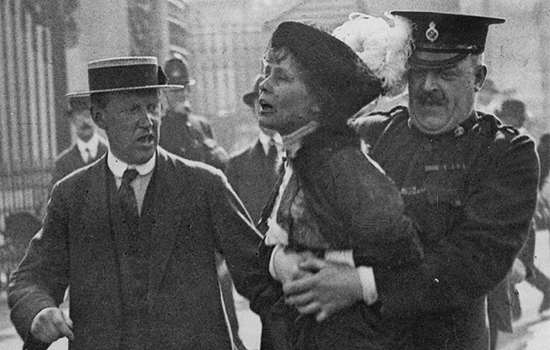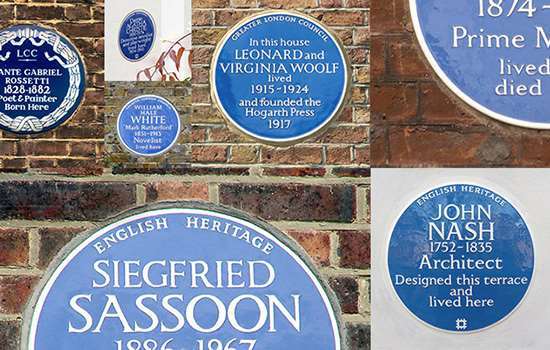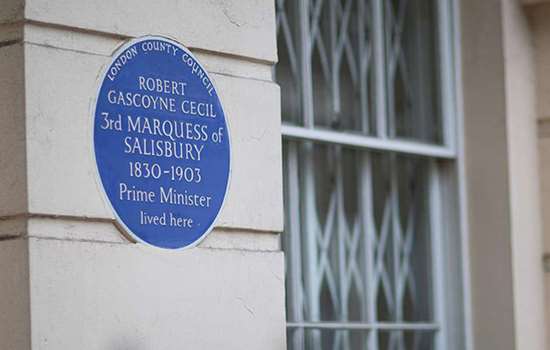SINGH, Princess Sophia Duleep (1876–1948)
Plaque erected in 2023 by English Heritage at Faraday House, 37 Hampton Court Road, Hampton Court, London, KT8 9BW, London Borough of Richmond Upon Thames
All images © English Heritage
Profession
Activist, nurse
Category
Medicine, Philanthropy and Reform
Inscription
Princess SOPHIA DULEEP SINGH 1876–1948 Suffragette lived here
Material
Ceramic
Princess Sophia Duleep Singh was a suffragette, Red Cross nurse, and critic of British rule in India. She uniquely straddled two world, using her royal connections to further the cause for women’s suffrage. She is commemorated with a blue plaque at Faraday House, 37 Hampton Court Road, Hampton Court, where her residence lasted over five decades.
EARLY LIFE
Sophia Jindan Alexandrovna Duleep Singh was born at 53 Holland Park Road on 8 August 1876 to Maharajah Duleep Singh (1838–93) and his first wife, Bamba Müller. The family’s association with that house is commemorated with an English Heritage blue plaque to Duleep Singh, who was the last Maharajah of the Punjab.
Sophia grew up and was educated at Elveden Hall, Suffolk. At her father’s request, Queen Victoria became her godmother.
A DIFFICULT CHILDHOOD
The Maharajah’s extravagant lifestyle, neglect of his wife and family and growing criticism of his treatment by the British government, caused great financial and emotional distress for his family. In March 1886, the family sailed for India but were stopped in Aden (modern-day Yemen) on the orders of the Viceroy of India, concerned that their arrival would cause unrest. While the family returned to England, the Maharajah – previously baptised as a Christian – returned to Sikhism and moved to Paris to be reunited with his mistress, Ada Weatherill. Later that year, he publicly relinquished responsibility for his family, at which point his wife retreated into alcoholism. Concerned for the children’s wellbeing, Queen Victoria placed them under the care of Arthur Craigie Oliphant, whose father had been the Maharajah’s equerry.
By the summer of 1887, the family were living in Oliphant’s house in Folkestone. That same year Sophia’s mother died. Queen Victoria pledged to look after the children and ensure that they were financially secure. Oliphant moved to Brighton and sent Sophia to a nearby boarding school.
On 8 May 1895, Sophia and her sisters were formally presented at court and Queen Victoria agreed that they would be called princesses. In 1896 Sophia, Bamba and Catherine were granted use of a grace and favour ‘apartment’ in Hampton Court – actually a large house named Faraday House – for their lifetimes.
FIRST EXPERIENCES OF INDIA
In 1902 the three sisters arrived in Delhi for the Durbar, a celebration of Edward VII’s coronation. Although excluded from the celebrations, they were allowed to travel north to Lahore. Shunned by British officials, the sisters were made welcome by the staunchly pro-British Harnam Singh, uncle to the Maharajah of Karpurthala, and the more critical Umrao Singh Sher-Gil and his wife. Sher-Gil introduced Sophia to the Theosophical Society and to Annie Besant.
Sophia remained in Lahore to explore the city, understand its history and learn its language. In August 1903, she returned to London newly interested in the welfare of the Indian seamen living there, and she raised funds to create a club for them in the Victoria Docks.
JOINING THE WOMEN’S SOCIAL AND POLITICAL UNION
In 1908, Sophia met Una Dugdale (1879–1975), a member of the Women’s Social and Political Union (WSPU). According to a fellow suffragette, Mary Blathwayt, Sophia was persuaded by Una’s arguments and joined the WSPU. From 1909 onwards she was active in her local branch in Kingston upon Thames. Sophia concentrated on fundraising and met Emmeline Pankhurst, who recognised the publicity that the princess could generate. Sophia took part in the march to Parliament on 18 November 1910 to protest against the decision to allow no more time for the suffrage bill. She witnessed physical force used by the police at the demonstration and intervened in an assault on one suffragette. Sophia was arrested on ‘Black Friday’ but charges were soon dropped.
ARREST AND THE WOMEN’S TAX RESISTANCE LEAGUE
In October 1909, the Women’s Tax Resistance League (WTRL) was founded; its members resurrected the political slogan of ‘no taxation without representation’ and refused to pay taxes. Sophia joined and in 1911 one of her diamond rings was impounded in lieu of non-payment of tax. It was bought at auction and returned to her by a fellow WTRL member. In December 1913, she appeared at Feltham police court once more for refusing to pay the same taxes.
Sophia took part in the 1911 census boycott, helped to distribute copies of Votes for Women and sold The Suffragette outside Hampton Court. The increasingly violent tactics used by the WSPU, including post box attacks and arson incidents, did not shake Sophia’s resolve. In 1914 she gave £51 to the WSPU, the largest individual donation that year.
LATER LIFE
The advent of the First World War led the WSPU to cease campaigning. In 1915, Sophia volunteered as a Red Cross nurse, looking after wounded Indian soldiers. She gave signed photos to Sikh soldiers and in 1916 gathered a group of Indian women to raise funds for a dedicated Indian soldiers’ welfare fund. Its success persuaded her to petition for a licence to hold regular street collections. The ensuing ‘India Day’ celebrations on 20 September 1918 raised funds to buy 50,000 huts to house sepoys (Indian soldiers serving the British) stationed across the world.
Sophia joined the Suffragette Fellowship and organised the flowers placed on the statue to Emmeline Pankhurst when it was unveiled in March 1930.
She died on 22 August 1948, aged 71. Her ashes were taken to India by Bamba in 1949.
FARADAY HOUSE
Faraday House is the only London address with a long association with Sophia; she probably moved there in 1896. It was her main residence over five decades and her base during the years she campaigned for women’s suffrage.
Her involvement in the local WSPU branch extended to selling suffragette literature outside the palace – a provocative and brave act, given her dependency on the government for her pension. The fact that Faraday House was raided by bailiffs seeking redress for non-payment of taxes makes the house part of the wider story of the women’s suffrage campaign.
Faraday House (divided since Sophia’s residence; part of it is now called Cardinal House) is a brick-built two-storey dwelling, dating from the early 18th century. The house derives its name from another famous resident (from 1848 to 1867), the scientist Michael Faraday, who is commemorated there by a rectangular stone plaque.
HISTORICAL REPUTATION
Sophia uniquely spanned the two very different worlds of the British court and the movement for women’s suffrage. She made full use of her royal title to generate news and support for female enfranchisement. She shrewdly chose political protests that the British authorities could not ignore and were pursued through the courts. Initially dependent on the goodwill of Queen Victoria, Sophia moved from dutiful loyalty in the 1890s to a position of overt criticism of British rule in India by 1907. This political awakening and consciousness of her Sikh heritage contributed to her militancy as a member of the WSPU. Interest in Sophia’s life has grown since the publication of Anita Anand’s biography (2015) and the parallel development of resources exploring Anglo-Sikh heritage in Britain.
FURTHER READING
- Anita Anand, Sophia: Princess, Suffragette, Revolutionary (London, 2015)
- Oxford Dictionary of National Biography (public library subscription required)


